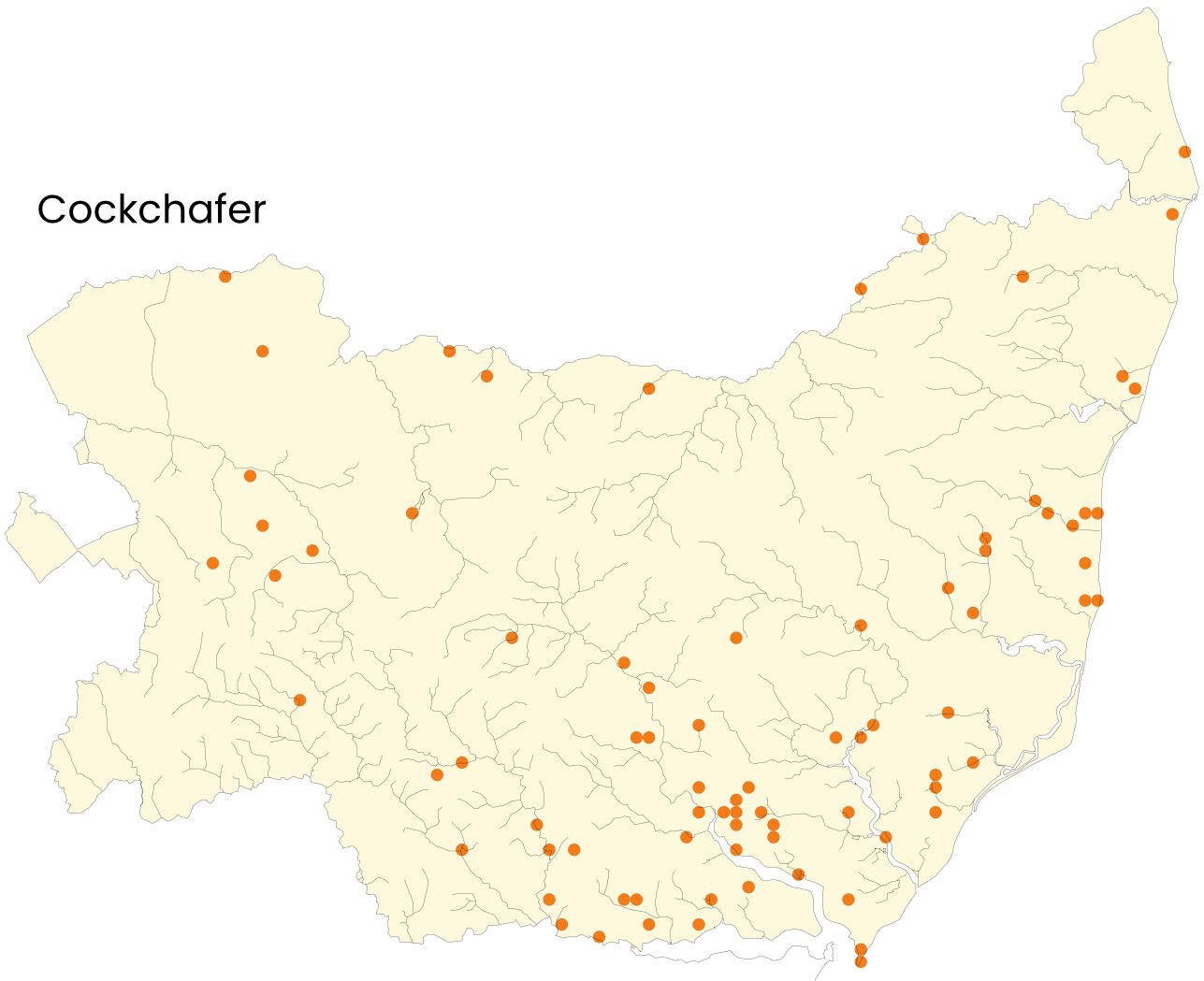Cockchafers are a relatively large beetles belonging to the Scarab family. Their name comes from Old English and means 'big beetle'. They fly from late April to July.
They have many nicknames, especially in East Anglia: Billywitch, Kittywitch, Buzzywitch, Spang beetle, Rookworm, Snartlegog, Oak-wib, Doodlebug, Cob worm, Midsummer dor, Maybug (they are often first seen in May), Mitchamador and Mezamadore are just a few.
© Nutmeg 66 (Flickr)
Adult cockchafers fly at around five mph and are one of the lightest beetles for their size in the UK, weighing just 0.4 – 0.9g.
Cockchafers have the last segments of their antennae expanded into flat, plate-like leaves, which sit in a distinctive fan-like arrangement.
These are the olfactory organs of the cockchafer, and this formation dramatically increases the space for chemosensors. They use them to find food sources and mates.
© William Van Niekerk (iNaturalist)
They grow up to 3 cm long, brown beetles mainly seen in the evenings flying around streetlights and brightly lit windows.
The white patches on the wing cases show that this is a young adult.
They have black/grey heads and pronotum covered in short hairs, whitish triangles on their sides and hairy bodies.
© Wolfgang Jauch (iNaturalist)
Their reddish-brown ribbed wing cases (elytra) meet in the middle without overlapping.
© Ron Voskuil (iNaturalist)
Left: Male © Adobe stock Right: Female © Sharp Spoods (iNaturalist) Slide bar to compare
Male or Female?
The males have seven "leaves" on their orange fan-like antennae, whereas the females have only six.
Cockchafer larvae are fat, creamy-white grubs with reddish-brown heads, a curved body with six legs and can be larger than the adults, growing to 4cm. They are a valuable food source for rooks, owls and bats, hence another nickname, Rook worm.
© Ron Voskuil (iNaturalist)

Common in the south of England and the Midlands, frequently found around hedgerows and gardens. They are attracted to light and often crash into lighted windows at night.
Distribution in Suffolk
Lifecycle
© Andrey Ponomarev (iNaturalist)
Adults emerge at the end of April or May, and mating usually occurs two weeks later. After emerging in the spring they usually live for five to seven weeks.
In France, it was believed that happy times were coming if a cockchafer flew into your house.
The pygidium
© Gilles San Martin (iNaturalist)
After mating the female lays her eggs and uses her pygidium to bury them about 10 - 20 cm deep in the earth.
She repeats this until she has laid between 60 and 80 eggs.
This video was filmed by Carolyn-Monika Görres for the blog "Understanding the invisible - insights into greenhouse gas research" https://carolyngoerres.wordpress.com.
The eggs hatch into larvae four to six weeks after the eggs are laid. They spend three to four years, sometimes even five years in colder climates, developing and growing to a size of about 4–5 cm, larger than the adult beetle.
© Philippe Rouzet (Flickr)
The larvae pupate in early autumn, and it takes six weeks for them to develop into adult cockchafers. After pupation, the young adult cockchafers continue to live underground, between 20 and 100 cm deep. They overwinter here before surfacing en masse the following spring, ready to begin the process all over again.
Because they spend so long as larvae, cockchafers appear in waves every three or four years, varying across regions.
There is also a larger cycle of around 30 years when they emerge in unusually high numbers.
Did you know?
In 1574, cockchafers emerged in such numbers in the Severn Valley that the volume of carcasses disabled watermills!
Edibility
© Jan Svetlik (Flickr)
Cockchafers have been eaten for centuries. The larvae are typically boiled or roasted and eaten as a snack. They also can be ground up and used as an additive to dishes such as soups, salads and sauces.
A 19th-century recipe from France for cockchafer soup reads: "Roast one pound of cockchafers – without wings and legs – in sizzling butter, then cook them in a chicken soup, add some veal liver and serve with chives on a toast".
A German newspaper from Fulda from the 1920s tells of students eating sugar-coated cockchafers.
The larvae can also be fried or cooked over open flames, although they require some preparation by soaking in vinegar to purge them of soil in their digestive tracts.
Left: Cockchafer © Paul Kitchener (Flickr) Right: Summer chafer © Krasnia (Flickr) Slide bar to compare
Cockchafer or Summer chafer?
The summer chafer (Amphimallon soltitiatis) is smaller, at about 20mm, and has a rounded tail end rather than a pointed one. Traditionally, it is associated with the Summer Solstice because the adults often emerge in the second half of June. However, the summer chafer can be found across the UK throughout June and July.
Spotting them
When to see them
Adults: Late April to July. Larvae: Year-round.
Remember to record your sighting if you are lucky enough to spot them in Suffolk!
© Reddad (iNaturalist)
